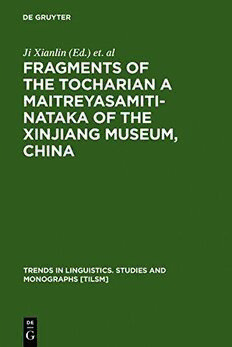
Fragments of the Tocharian a Maitreyasamiti-Nataka of the Xinjiang Museum, China PDF
Preview Fragments of the Tocharian a Maitreyasamiti-Nataka of the Xinjiang Museum, China
Fragments of the Tocharian A Maitreyasamiti-Nätaka of the Xinjiang Museum, China W DE G Trends in Linguistics Studies and Monographs 113 Editor Werner Winter Mouton de Gruyter Berlin · New York Fragments of the Tocharian A Maitreyasamiti-Nätaka of the Xinjiang Museum, China Transliterated, translated and annotated by Ji Xianlin in collaboration with Werner Winter Georges-Jean Pinault Mouton de Gruyter Berlin · New York 1998 Mouton de Gruyter (formerly Mouton, The Hague) is a Division of Walter de Gruyter & Co., Berlin. ® Printed on acid-free paper which falls within the guidelines of the ANSI to ensure permanence and durability. Die Deutsche Bibliothek — Cataloging-in-Publication-Data Fragments of the Tocharian Α Maitreyasamiti-Nätaka of the Xinjiang Museum, China / transliterated, transl. and annotated by Ji Xianlin. In collab. with Werner Winter ; Georges-Jean Pinault. - Berlin ; New York : Mouton de Gruyter, 1998 (Trends in linguistics : Studies and monographs ; 113) ISBN 3-11-014904-4 © Copyright 1998 by Walter de Gruyter GmbH & Co., D-10785 Berlin All rights reserved, including those of translation into foreign languages. No part of this book may be reproduced or transmitted in any form or by any means, electronic or mechanical, including photocopy, recording or any information storage and retrieval system, without permission in writing from the publisher. Disc conversion and printing: Arthur Collignon GmbH, Berlin. Binding: Lüderitz & Bauer, Berlin. Printed in Germany. Contents 1. Introduction 1 1.1. Explanatory notes concerning the fragments 1 1.2. Fragments of the Maitreyasamiti-Nätaka published by E. Sieg and W. Siegling in Tocharische Sprachreste 1 1.3. Old Uighur versions or translations 3 1.4. Parallel versions in other languages 4 1.4.1. Chinese 4 1.4.2. Tibetan 5 1.4.3. Khotanese Saka 5 1.4.4. Sogdian 5 1.4.5. Pali 5 1.4.6. Sanskrit 6 1.5. Brief outline of the contents of the 1st, 2nd, 3rd and 5th acts 6 1.5.1. Story from the "Tales of the Wise and the Fool" 7 1.5.2. Act I 13 1.5.3. Act II 14 1.5.4. Act III 14 1.5.5. Act V 15 1.6. Technical remarks 16 1.6.1. Principles of section division of the text 16 1.6.2. Previous editions of fragments of the Yanqi manuscript 17 1.6.3. Abbreviations of reference works 18 1.6.4. Table of abbreviations 19 1.6.5. Signs of transliteration 19 2. Edition of the fragments (transliteration, translation, notes) 21 2.1. Act I 21 1.1. YQ 1.30 21 1.2. YQ 1.29 27 1.3. YQ 1.32 31 1.4. YQ 1.28 35 1.5. YQ 1.17 39 1.6. YQ 1.16 43 1.7. YQ 1.15 49 vi Contents 1.8. YQ 1.3 55 1.9. YQ 1.9 59 1.10. YQ 1.1 63 2.2. Act II 67 11.1. YQ 1.2 67 11.2. YQ 1.4 73 11.3. YQ 1.42 77 11.4. YQ 1.8 81 11.5. YQ 1.14 89 11.6. YQ 1.13 95 11.7. YQ 1.5 101 11.8. YQ 1.6 105 11.9. YQ 1.7 109 11.10. YQ 1.12 113 11.11. YQ 1.11 119 11.12. YQ 1.10 123 11.13. YQ 1.31 129 11.14. YQ 1.33 133 11.15. YQ 1.43 137 2.3. Act III 143 111.1. YQ 1.21 143 111.2. YQ 1.22 149 111.3. YQ 1.44 155 111.4. YQ 1.23 159 111.5. YQ 1.24 163 111.6. YQ 1.25 167 111.7. YQ 1.26 171 111.8. YQ 1.41 175 111.9. YQ 1.20 181 111.10. YQ 1.18 187 III.l 1. YQ 1.19 191 III.12. YQ 1.27 195 2.4. Act V 199 V.l. YQ 1.39 199 2.5. Fragments not yet identified 205 N.l. YQ 1.34 205 N.2. YQ 1.35 206 N.3. YQ 1.36 206 N.4. YQ 1.37 208 N.5. YQ 1.38 210 N.6. YQ 1.40 211 Contents vii 3. Indices 213 3.1. Index verborum of the fragments of the Yanqi manuscript 213 3.2. Index of verb forms (Verbalverzeichnis) 269 3.3. Glossary of non-verbal forms 280 Plates (photographs) 303 Postscript 392 1. Introduction 1.1. Explanatory notes concerning the fragments In the winter of 1974, in the Yanqi district of the Xinjiang Autonomous Region, China, close to a 1000-Buddha Temple, some forest workers dis- covered accidentally 44 leaves, i. e., 88 pages of the manuscript remains of a Tocharian A version of the Maitreyasamiti-Nätaka. Although they are far from complete, they are the longest manuscript remains of this text discovered till now and are therefore worth notice. The original manuscripts are written in Central Asian slanting BrähmT on yellowish paper, circa 32 cm in length and 18.5 cm in width. Most of them contain eight lines on every page; on a few of them, only six lines survive. Having been burnt by fire, the manuscript remains are heavily damaged, mostly on the left side; the left margin and corners are always entirely lost. There is not even a single page or a single line complete. On the most damaged pages, there remain only a few words. The order of the pages is totally in confusion, which causes a lot of difficulties for the deciphering work. A few manuscript remains of the same text have already been published in E. Sieg and W. Siegling's Tocharische Sprachreste (Berlin—Leipzig, 1921); they are in a similarly damaged condition. 1.2. Fragments of the Maitreyasamiti-Nätaka published by E. Sieg and W. Siegling in Tocharische Sprachreste In 1906, the German archeologists Albert Grünwedel and Albert von Le Coq discovered during the third Prussian Turfan Expedition some Tocharian A fragments of the Maitreyasamiti-Nätaka texts in Xinjiang, China. These fragments were later on published by two German scholars, Emil Sieg and Wilhelm Siegling, who had deciphered the Tocharian lan- guage, in two volumes, one containing facsimiles, the other the roman- ized transliterations (Berlin-Leipzig: Walter de Gruyter & Co., 1921). In the following, I enumerate the texts of the Maitreyasamiti-Nätaka ac- cording to the original numbers of Sieg and Siegling.
